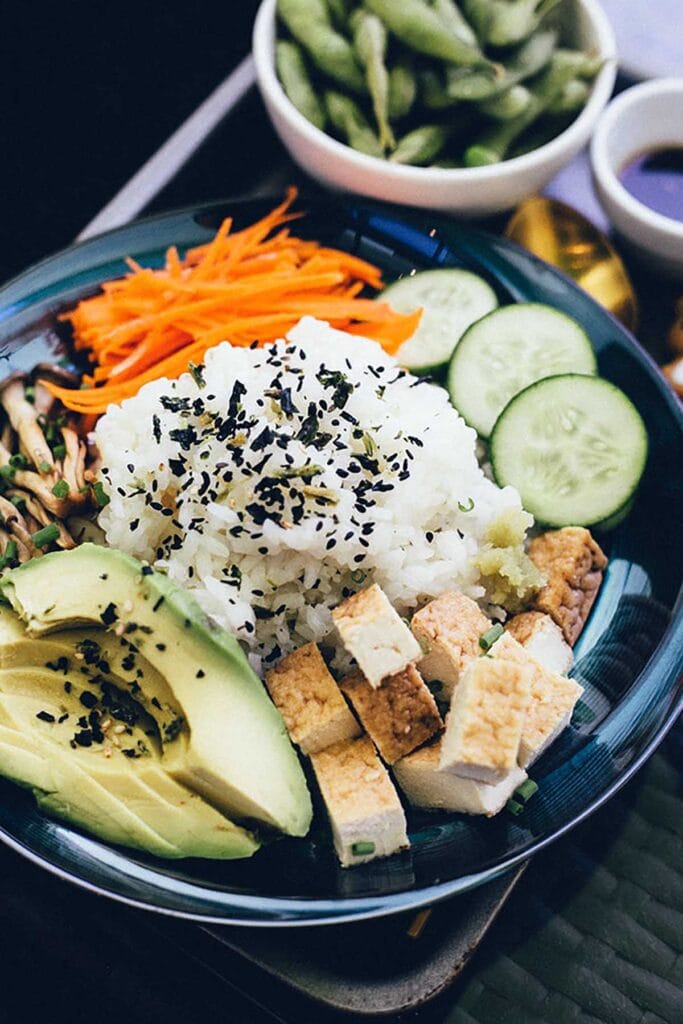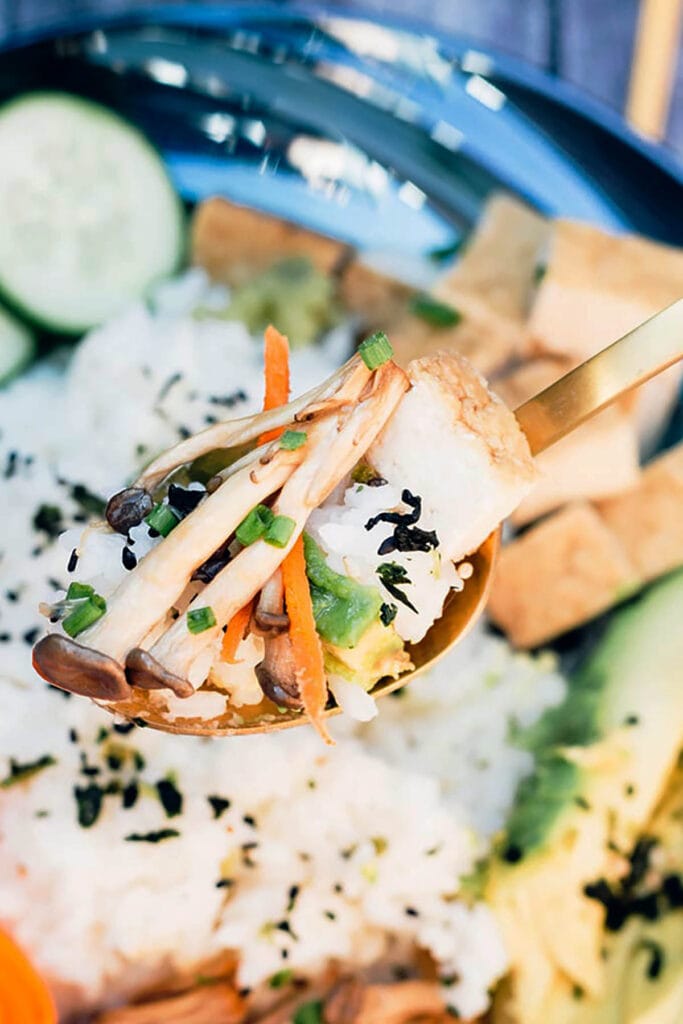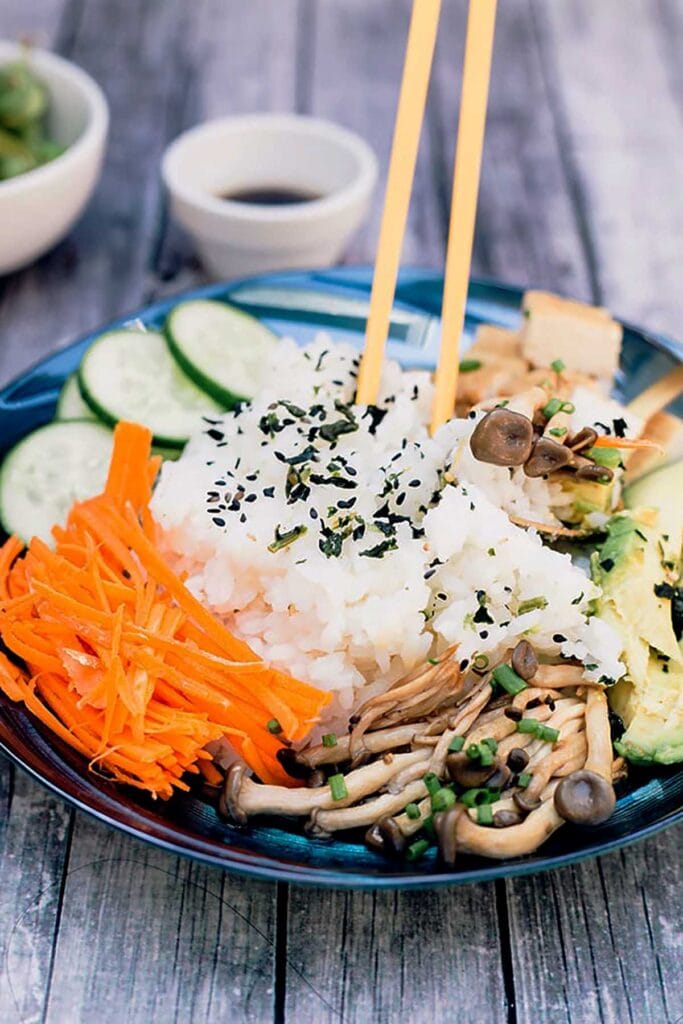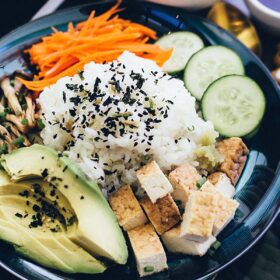Learn how to make this delicious vegan sushi bowl; quick, simple and full of authentic Japanese flavors! Made using readily available ingredients, it’s a restaurant-worthy dish!

If you’ve tried my bibimbap or kimbap already, you’ll definitely love this plant-based homemade sushi bowl!
This dish is easy to make, fun to eat, and you can customize them to include any of your favorite mix-ins!
FREE EBOOK SERIES! 5 SECRETS FOR FOOLPROOF VEGAN DESERTS
Whats the difference between a poke bowl and a sushi bowl?
Poke is a traditional Hawaiian dish consisting of raw fish, typically tuna, marinated in soy sauce and other seasonings and often served over rice.
On the other hand, a sushi bowl typically combines ingredients commonly found in sushi, such as raw fish, rice, and vegetables, but is served, deconstructed, in a bowl rather than rolled in seaweed.
Why you’ll love this recipe
- Quick and easy to make. There is barely any hands on time and the recipe comes together in minutes.
- Highly nutritious. A combination of delicious veggies, tofu, seeds and healthy sushi rice hits all your nutritional targets – protein, wholesome carbs, vitamins and minerals!
- Kid-friendly. This sushi bowl’s delicious flavor and color will attract even your picky eaters. It is also easily customized to include any fan favorites!
- Restaurant-worthy. For a fraction of the price, you can recreate a fabulous Japanese takeout dish at home.
Ingredients needed
Here is a list of all the ingredients you’ll need to make a delicious sushi bowl.
Rice base
- Sushi rice. You can also use regular brown or another short grain white rice.
- Water. To cook.
For rice liquid seasoning
- Rice vinegar. Or white vinegar.
- Mirin. A rice wine that is used to enhance flavors in Japanese recipes.
- Salt. To taste.
- Caster sugar. To balance sweet and savory.
- Lemon juice. To add a fresh citrus tang.
For dipping sauce
- Shimeji mushrooms. A mushroom with a delecate, mild flavor.
- Tamari. A Japanese sauce.
- Mirin. Traditional rice wine.
- Sesame oil. Or any other neutral flavored oil.
Toppings
- Tofu or Seitan. Cubed and fried.
- Carrot. Julienned.
- Cucumber. Sliced.
- Avocado. Sliced.
- Black sesame seeds. To serve.
- Seaweed (nori) flakes. To serve.
How to make a sushi bowl
Step 1 – Rinse the rice. Rinse off rice using a colander for at least 1-2 minutes. Place in a sieve and allow the rice to drain over a bowl for 45 minutes.
Step 2 – Prepare rice liquid seasoning. While the rice drains, prepare your rice seasoning by heating the mirin, salt, rice vinegar, lemon juice and caster sugar in a small pot until everything is dissolved. Don’t boil.
Step 3 – Cook the rice. After draining, add rice to a heavy based small pot. Add 1 ⅓ cups of water and cook over medium-high heat. Once boiling, lower the heat slightly and cover with a lid to let the rice simmer for at least 15 minutes. When the rice is cooked, leave the pot uncovered for at least 10 minutes.
Step 4 – Mix rice and liquid seasoning. Add rice to a bowl and mix in the liquid seasoning using a bamboo paddle or a large spoon. Fluff the rice with a cutting action as you go. Once the rice has absorbed all the sushi seasoning, it’s ready to use.
Step 5 – Prepare the dipping sauce. In a pan, add mirin, shimeji mushrooms, sesame oil and tamari over medium heat. Keep stirring and cook the mushrooms until they are soft and release their moisture in the pan. Remove the mushrooms. The remaining sauce will be used as the dipping sauce.
Step 6 – Assemble. Transfer rice to a serving bowl and surround it with cooked mushrooms, avocado, carrot, cucumber and tofu. Sprinkle seaweed flakes and sesame seeds on the rice and serve with the dipping sauce.

Tips to make the best recipe
- Experiment with different types of rice. Instead of traditional sushi rice, you can also use brown or white rice.
- Add veggies. To add colors and flavors to your bowl, you can add your favorite veggies such as pumpkin, sweet potato, edamame or eggplant. Pickled ginger is also another great option!
- Add sauces. To enhance the spice profile of this dish, you can use various sauces such as spicy mayo, sriracha, ponzu, and wasabi.
Storage instructions
To store: Place any leftovers in an airtight container, cover and store in the refrigerator for 2-3 days.
To freeze: To store for a longer term, put individual ingredients in freezer-safe containers or wrap them tightly in plastic wrap and place them in the freezer for up to 2-3 months.
Reheating: Reheat in the microwave or pot for a few minutes until warm enough to enjoy.

More Asian-inspired recipes to try
- Raw Sushi Rolls with Kelp Noodles and Tahini Soy Dipping Sauce
- Singapore Rice Noodles
- Korean BBQ sauce
- Sushi Bake
Frequently asked questions
While traditional sushi rice is commonly used for sushi bowls, you can also use other types of rice like brown rice, quinoa, or cauliflower rice to make them healthier.
This is one of the most important steps in ensuring authentic Japanese flavors in this dish. That being said, if you’re pressed for time, unseasoned rice will still make an enjoyable meal.
You can use various plant-based proteins such as marinated and sautéed tofu, seitan, tempeh, chickpeas, black beans, or even mock seafood alternatives. Season them well with your favorite marinades or spices for added flavor.

Vegan Sushi Bowl
Ingredients
For rice base:
- 1 cup sushi rice
- 1 1/3 cups water
For the sushi rice seasoning:
- 2 tablespoons rice vinegar
- 1 tablespoon mirin
- 1 teaspoon fine salt
- 1 1/2 teaspoons caster sugar
- 1 1/2 teaspoons lemon juice
For the dipping sauce:
- 1 cup Shimeji mushrooms
- 2 tablespoons tamari
- 2 tablespoons mirin
- 1 teaspoon sesame oil
For the toppings:
- 4 oz tofu (114 g) firm or fried, cubed
- 1/2 cup carrot julienned
- 1/2 large cucumber sliced
- 1 avocado sliced
- 1/2 teaspoon sesame seeds black
- 1/2 teaspoon seaweed flakes
Instructions
- Rinse rice off in a colander about 5 or 6 times, then place in a sieve and let it drain over a bowl for 45 minutes. This step is important.
- While waiting for the rice to drain, prepare sushi liquid seasoning by heating rice vinegar, mirin, salt and caster sugar and lemon juice in a small pot till sugar is dissolved. Don't boil.
- After the rice has drained, add it and 1 1/3 cup of water to a heavy based small pot. Bring to a boil.
- Once boiling, cover with a lid and reduce to a simmer. Let cook for 15 minutes exactly. Avoid opening the pot. Once 15 minutes is up, turn the stove off and leave the pot covered for 10 minutes.
- Transfer rice to a bowl and pour sushi seasoning over it. Using a bamboo paddle or large spoon, with a cutting motion, stir/fluff seasoning into the rice. The cutting motion will help to aerate the rice.
- Once cooled, the rice should be sticky and have absorbed all the liquid seasoning. It is now ready to use!
- In a pan, place the Shimeji mushrooms, tamari, mirin and sesame oil over a small to medium heat. Let cook for a few minutes at most, stirring occasionally, till mushrooms soften and release their moisture into the pan – this liquid is what you'll use as your dipping sauce. Remove the mushrooms.
- Place rice in a bowl, and surround with prepared mushrooms, carrot, avocado, tofu, cucumber. Sprinkle sesame seeds and seaweed flakes on the rice. Serve with dipping sauce!
Christie says
KK says